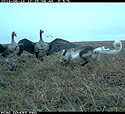Using a network of camera traps, scientists from the New York-based Wildlife Conservation Society (WCS) have documented how oil development in the Arctic tundra can increase the presence of predators that attack nesting bird populations. WCS biologist Joe
Liebezeit placed camera traps — automated cameras that take photos whenever an animal triggers an infrared sensor — near drilling sites in Alaska’s Prudhoe Bay oilfields and in a remote, undeveloped location in the tundra. The traps showed a larger number of predators — including foxes, ravens, and gulls — preying on nesting birds near the oilfields. Oil drilling structures not only provide nesting and denning territory for predators, but garbage from the drilling areas also provides food, increasing the predators’ numbers. “The presence of people and structures enable these [predators] to live in areas that otherwise would not be preferred or suitable habitat, or to do so in greater numbers than would normally be the case,” said Liebezeit. “As a result, they have more access to the nests of migratory birds and can exploit a vulnerable food source.”
View gallery
WCS
An Arctic fox charges a goose nest in the Prudhoe Bay oilfields